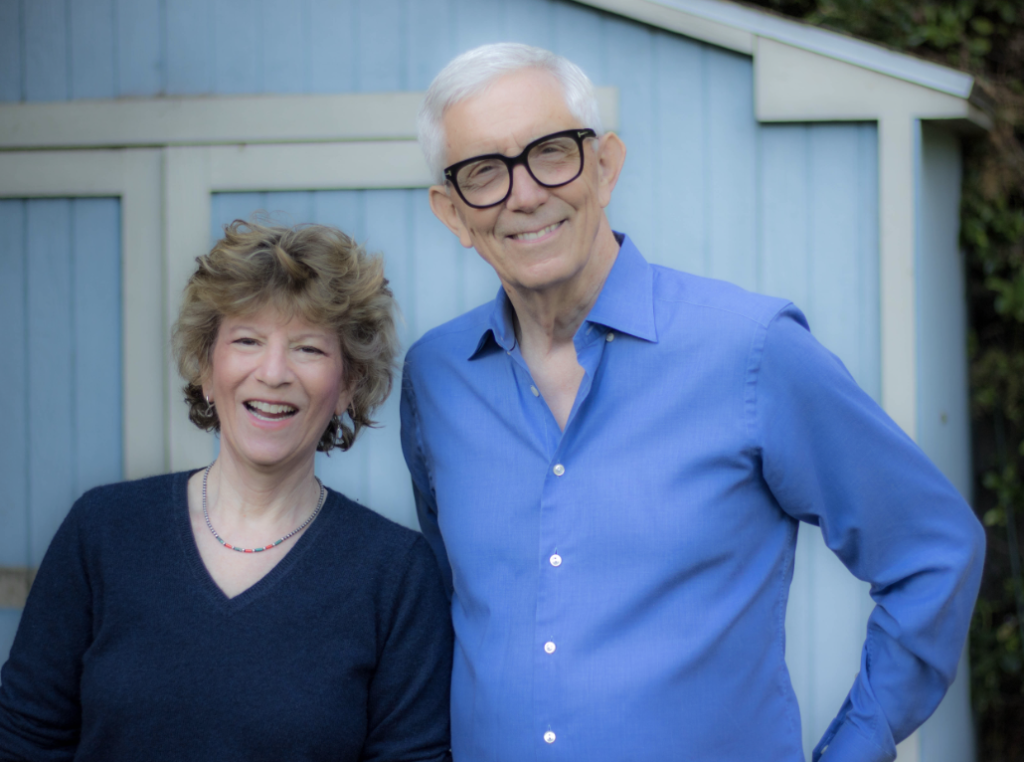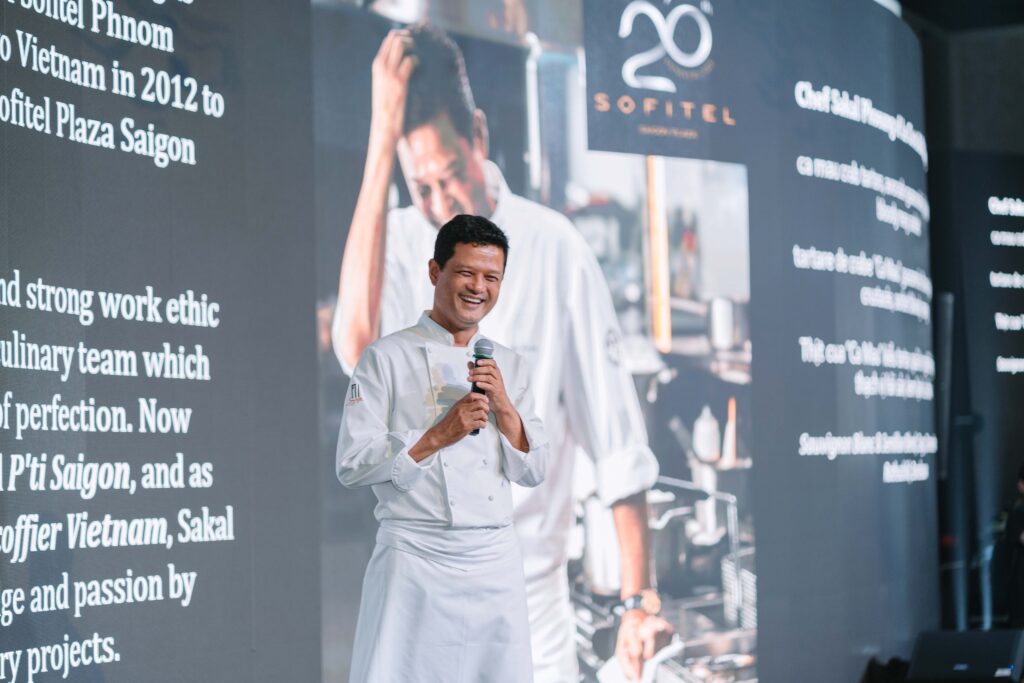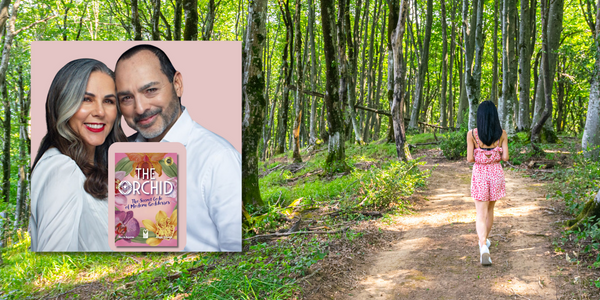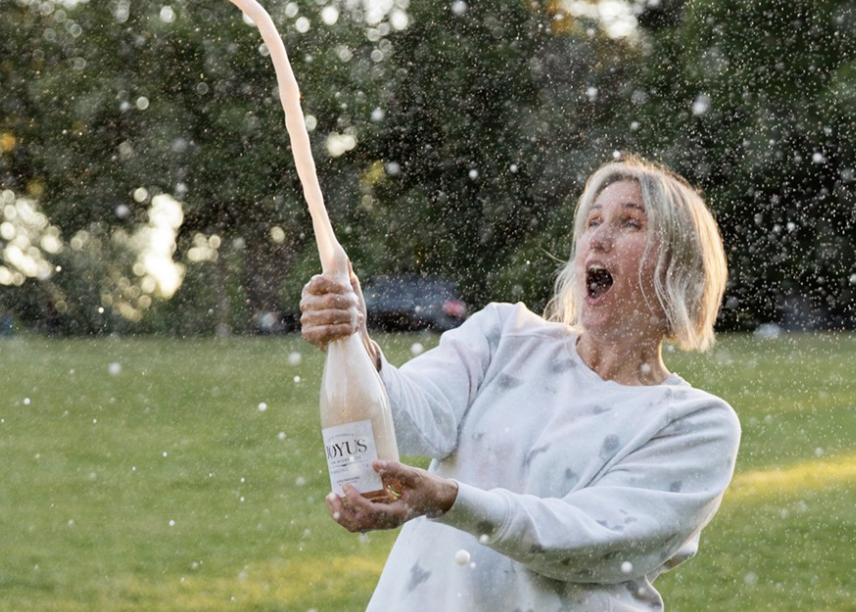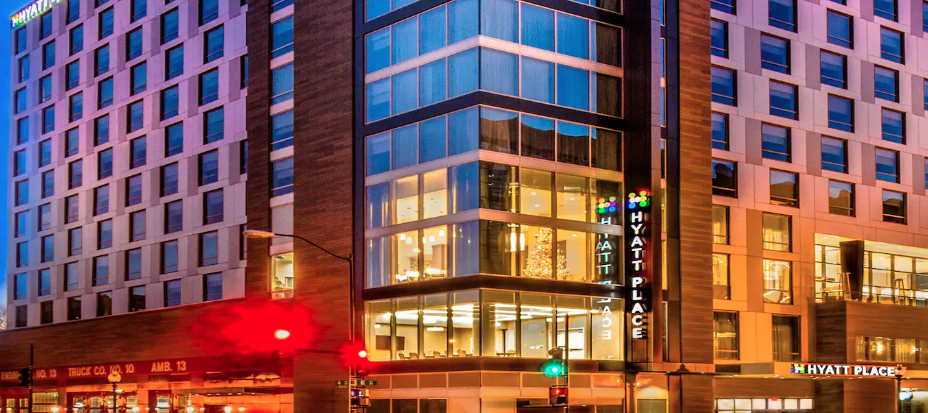Ever Get so Inspired you had a ‘Chocolate Epiphany? Honeymoon Chocolate Wants to Help you
Have you ever felt better after a good meal? The flavors that linger. The euphoria that captures your attention. You’re inspired. You can’t help but smile.
Today we’re talking with Honeymoon Chocolates’ Cam Loyet.
You use the phrase ‘Chocolate Epiphany’. What does it mean to you?
So up in Bloomington, Illinois, where Hayley and I met there’s a restaurant called the Epiphany Farms it’s farm to table. It’s expensive because you’re getting the highest quality meal. We were only college students. So we really couldn’t afford it, except for once a year. Every meal I had there, I had what seemed like this Epiphany with food where everything tasted better than any meal I’d had in the last 4 weeks. It was just incredible and we hope that you know our chocolate can do that for our customers.
It’s this experience where only a single bite can tide you over or a little bit goes a long way, because not only was the flavor so incredible, but it lasts 5 or 10 minutes, the flavor in your mouth just lingers.

That’s where “Chocolate Epiphany“ comes from being sweetened with honey. It doesn’t have to be sweetened with cane sugar.
Honey is as local as it gets and it’s as unrefined as it gets with the sweetener completely untouched, raw unfiltered honey.
A lot of our competitors use coconut, sugar, monk fruit or stevia, and those are all processed ingredients, one way or another. Even cane sugar is processed.

So we’re doing our best to create this experience through chocolate and communicate with our customers; and hopefully it becomes an epiphany in the process.
Honeymoon chocolate is a love story, a health story, a delicious flavor, story and an environmental story. What else can we add to that?
It’s definitely a love story, my girlfriend at the time, now my wife; we met at Illinois Wesleyan University, and started this crazy business of sweetening chocolate with local honey. Yes, we need chocolate with local honey. And it’s a bittersweet journey. We instantly found out all of the trials and tribulations of owning our own business.
Also the cocoa supply chain. It’s a lot like the diamond industry where there’s a lot of slave labor and a lot of issues with those who really do all the hard work and effort. There’s a lot of effect we can have as we scale.
Yeah, a love story. It;’ sweet. It’s romantic. That’s one of the main reasons why we named it Honeymoon Chocolates because it always has its place at romantic events.
We do our best to attract those who want to gift our product. A lot of our customers do gift our chocolate.
It’s environmental as well. It’s all compostable packaging. We have a goal of using only clean energy in the future, but again, it continues to be bitter sweet because chocolate is a very power hungry industry. It takes a lot of effort and energy to manufacture chocolate. It takes a lot of effort and energy just to get the cocoa here.
There’s a lot of effort in our industry to be transparent on the energy that is being used in the emissions and our goals to be a bit more transparent on that as well. But we do our best.
I never want our Honeymoon Chocolates wrapper to be out on the streets blowing in the wind without the ability to biodegrade or compost. So we go a little bit more a little bit above and beyond.
Visits Honeymoon Chocolates at: https://hmchocolates.com
On Instagram, at: www.instagram.com/honeymoonchocolates
On Facebook, at: https://www.facebook.com/honeymoonchocolates
YOU MIGHT ALSO LIKE
Bubbly East Coast Prosecco Tasting! Discover with Wine Expert Alan Tardi Wed June 26th at New York Wine Studio
DC Heads to NYC for Prosecco! Taste and Discover with Wine Expert Alan Tardi Wed June 26th at New York Wine Studio
Prosecco has gone from a little known mountain fizz to a vinous superhero, overtaking Champagne (and every other sparkling wine out there) and enjoyed by wine drinkers throughout the world, as the base of a cocktail or an everyday quaff.

But despite its huge popularity, most people don’t know much about it.
And there is much more to Prosecco than many people are aware.
”My objective is to
clarify the critical differences
between the original ancient Conegliano Valdobbiadene Prosecco and
the DOC Prosecco that was enacted in 2010.”
Alan Tardi
New York Wine Studio
Prosecco is produced only in Italy, in the Northern regions of Veneto and Friuli, and there are three official Prosecco appellations.

Prosecco DOC
One of them, Prosecco DOC, was created in 2010. It occupies a huge, mostly flat area encompassing almost two entire regions and accounts for most of the 700+ million bottles of Prosecco produced each year.
Conegliano Valdobbiadene Prosecco DOCG
Conegliano Valdobbiadene Prosecco DOCG is a tiny area in the foothills of the Dolomites consisting of 15 small municipalities in the province of Treviso. This is the ancient winegrowing area where Prosecco was born and made a miraculous comeback in the aftermath of World War II.

New York Wine Studio’s Alan Tardi
Besides its pedigree, there are numerous factors of the Conegliano Valdobbiadene enclave that distinguish it from any other winegrowing area in the world: complex and diverse topography, variety of soils, native grape varieties, distinct sub-areas, ancient history, and varied typology—bubbly, fizzy, and still; secondary fermentation in tank or in bottle, leaving sediment in the bottle (known as Ancestral Method) or removing it (Traditional Method).

In this class—which takes place right in the middle of National Prosecco DOC week—we will discuss the origin and evolution of Prosecco in the Conegliano Valdobbiadene area. We will also examine the two additional Prosecco appellations created in 2010.
But most of the time will be devoted to exploring and tasting Conegliano Valdobbiadene Prosecco through a lineup of 8 exceptional terroir-driven wines, in a variety of styles, that demonstrate the unique characteristics, complexity, and diversity of the original Prosecco.
Participants will also learn how to say “CONEGLIANO VALDOBBIADENE” like an Italian!

Alan Tardi has arranged a fantastic lineup of unusual and exceptional wines (half of them are coming directly from Italy) which demonstrate the various factors that characterize the complexity and uniqueness of Conegliano Valdobbiadene: Different production methods (“Tranquillo” i.e. still, Martinotti, Classico/Traditional, Ancestral); frizzante, spumante; single vineyards, Rive, native grape varieties; diverse, soils, terroirs and topographies.
List of Wines
- Prosecco Tranquillo DOCG “Il Canto Antico” — BORTOLOMIOL*
- Colli Trevigiani IGT Verdiso Frizzante Sui Lieviti — GREGOLETTO
- Progetto 5 Varietà Conegliano Valdobbiadene DOCG Brut — MARCHIORI*
- Conegliano Prosecco Superiore DOCG Rive di Ogliano Extra-Brut — BIANCAVIGNA
- Superiore di Cartizze Brut DOCG — RUGGERI*
- Superiore di Cartizze DOCG “Private” Rifermentato in Bottiglia 2014 — BISOL
- Conegliano Valdobbiadene Prosecco Superiore DOCG Rive di Carpesica “S.C. 1931” Metodo Classico — BELLENDA*
- Valdobbiadene Prosecco Superiore DOCG Asciutto, Rive di Colbertarldo, Vigneto Giardino — ADAMI
- Torchiato di Fregona Colli di Conegliano DOCG “Ciàcoe” 2016 — CA’ DI RAJO*
*Shipped directly from the winery in Italy
Find more information and buy tickets at New York Wine Studio or at the link below.
https://www.newyorkwinestudio.com/original-prosecco
Bob Dylan’s Bourbon Feud: Heaven’s Door Kentucky vs Tennessee
Bob Dylan’s Bourbon Feud: Heaven’s Door Kentucky vs Tennessee
Heaven’s Door Spirits, Bob Dylan’s highly awarded collection of super-premium American whiskeys, is turning up the heat on the age-old debate of which state, Tennessee or Kentucky, makes the best bourbon.
For as long as corn’s been cracked and stills have bubbled, Kentucky and Tennessee have been turning pristine limestone water and grains into a coveted amber elixir.
Heaven’s Door’s Great State Bourbon Debate rekindles the friendly feud
Heaven’s Door’s Great State Bourbon Debate rekindles the friendly feud between these two bourbon powerhouses, inviting whiskey lovers everywhere to put their palates to the test and voice their opinion.
Heaven’s Door sets itself apart as the first brand to offer both a Kentucky and Tennessee bourbon, giving fans a unique chance to compare.
The brand’s Kentucky Straight Bourbon, Ascension, and Tennessee Straight Bourbon, Revival, are made from high rye mash bills with grains largely sourced local to the distillery, and barreled at the same proof, yet yield vastly different taste profiles. Heaven’s Door invites you to level set, savor and decide which bourbon pleases your palate and wins your heart.
A Tale of Two Bourbons
Many folks mistakenly believe that bourbon can only be made in Kentucky, but the truth is, bourbon can be crafted anywhere in the U.S.
What makes an American whiskey a true bourbon is a special set of rules: it has to be made with at least 51% corn, distilled at a certain proof, and aged in new oak barrels.
Kentucky and Tennessee both have storied histories of producing excellent bourbon, with differences in water and climate producing distinct flavors.
Kentucky’s limestone water and Tennessee’s pure spring water are both famous for helping yeast thrive during fermentation.v
Differences in flavor profile come from the type and provenance of the grains used, the type of yeast used, water quality, the proof at distillation and the particular wood used to make oak barrel.
Even the location of the barrel warehouse, the circulation of air between the barrels being stored and where the barrels are within the warehouse (high up or near the bottom) all conspire to give impart flavor differences.
Heaven’s Door Kentucky Straight Bourbon, Ascension
Heaven’s Door Kentucky Straight Bourbon, Ascension, is a unique blend of two premium Kentucky straight bourbons aged for over five years and non-chill filtered, boasts warm and slightly sweeter notes of vanilla and baking spices. The limestone-filtered water of Kentucky, renowned for its purity, plays a key role in developing these rich flavors.
Heaven’s Door Tennessee Straight Bourbon, Revival
Heaven’s Door Tennessee Straight Bourbon, Revival, also aged for over five years and non-chill filtered, offers a drier profile with complex and sharp flavors. Unlike many Tennessee bourbons, Revival skips the “Lincoln County Process” – a charcoal filtering step – allowing the natural flavors of the local non-GMO grains to shine through, resulting in a lingering finish with hints of caramel, cinnamon, and nutmeg.
“We wanted to fan the flames of this old debate
between Kentucky and Tennessee bourbon
and showcase
our outstanding expressions of both styles.
We’re excited to hear what consumers think and how they experience these two classic bourbons.”
Alex Moore
Master Blender and COO
Heaven’s Door Spirit
Heaven’s Door marries art and craft in every bottle, drawing inspiration from Bob Dylan’s restless spirit to continually innovate. By sourcing non-GMO grains and honoring each state’s natural elements, the distinct character of each bourbon is evident in every sip.
Yo DC! Following your Heart and Need Media Attention? Reach to Publicity For Good, CEO Heather Holmes explains
Yo DC! Following your Heart and Need Media Attention? Reach to Publicity For Good, CEO Heather Holmes explains
Publicity for Good is a millennial run communications firm that provides high-level disruptive, publicity and social media services for wide array of purpose driven clients in the food, beverage and beauty industry.
In 2016 by Heather Holmes former miss Ohio international celebrated publicist and Forbes 30 under 30 nominee publicity for good has built a reputation as the countries number one PR agency for CPG brands that have social causes built into their DNA.

Publicity For Food CEO Heather Holmes
Today’s conversation with Heather Homes from PublicityForGood.com has been edited for length and clarity. For the full, un-edited conversation, visit our YouTube channel here.
Joe Winger:
Heather Holmes from PublicityForGood.com. I’m a big fan because you’ve helped us facilitate a lot of previous conversations about food and drink and nutrition and all the things we like talking about.
What’s the most important thing that you want to share with the audience today?
Heather Holmes:
I really want to take away the unknown or worry about getting in the media. I want to make it more accessible to amazing brands and people.
So I definitely want to share tactical advice that if someone is reading this, they have a good story in business, they have the confidence that their story is good enough and they could absolutely make an impact and grow their business by getting in the media.
Joe Winger:
Starting with the basics, let’s pretend I have a company, I think I want public attention. I want to reach out to someone like you.
So what should I be thinking about? What do I present to you as a step one?
Heather Holmes:
Step one is really the intentionality of why you want to get in the media. What’s your goal? Are you wanting to reach more people? Are you wanting to get your story out there?
Are you wanting more sales and more people to buy your product?
You really need to know. Where you’re going first, and if you don’t know where you’re going, or you don’t have a vision, then it’s really hard to help you.
But if you have clarity there, then we can really pull back and help you identify your story, how you’re different, your why, and why your product and or company, would be really great to be in the media.

The PublicityForGood Team
Joe Winger:
Now, looking at the grand scheme of the campaign, what kind of a campaign should we be looking for: expectations, results?
Heather Holmes:
After we know our outcome that we’re wanting to get more sales, more backlinks, or name in the media, then what I like to do first is work with every entrepreneur, and even if you have a product, to really reflect in “why your story matters”
Why does your product matter?
If you’ve never been in the media before, I take people for an exercise where I have them draw on a piece of paper, them as a baby, to where they are now.
I have them write the key pivotal moments that have happened in their life that have made them start that company, because those little components are absolutely a part of your story.
I’ve been in the media 700 plus times: Inside Edition, Fox News, The New York Coast, incredible media, but it hasn’t always been about being a publicist, right?
Yes. I’m the founder of Publicity For Good, but a lot of that has been my story or building a seven figure company from an airstream.
Now I have almost two under two with a third on the way.
So you need to have your key pivotal moments because those are things you can talk about in the media.
Then we need to look at what’s going on in the news and how we bridge the gap between your product. Relevancy.

Joe Winger:
People may not know you are a former Miss Ohio International. Can you tell us a lesson you learned from being a former Miss Ohio International that you’re using in today’s work?
Heather Holmes:
It’s really all about your platform and reaching new audiences.
When I was building my company I decided I wanted to get into pageants. I wanted to meet a community of like minded people that wanted to make a difference in the world.
It was a way for me to have a platform because at the time I was talking about why you absolutely can build a profitable business. But also make a difference in your community and make a difference amongst your team. And really just build an incredible legacy.
So that was why I did the pageants.
I did a bunch of publicity and again, it made me relevant and timely because that was what got me in the media because I was Miss Ohio and I was only Miss Ohio International for a period of time.
So it gave me that relevancy. So you have to be relevant.
You have to bridge the gap between what’s happening in the news, or we often use Awareness Days, National Nutrition Month, National Social Media Day, and you have to position your product or yourself as the solution.
[For example], we were talking about an incredible juice brand, but most pitches I see are very promotional, right? It needs to be how you or your product simplifies people’s lives. How are you adding value? Or you don’t have a product you need to inspire people.

Joe Winger:
You’re growing a 7- figure business. What’s it like growing a huge business while you’re taking care of your kids and for a while you were living out of your Airstream
Heather Holmes:
We lived out of a 23 foot airstream for 3 1/2 years. I went from dating to engaged, to married to [my first child] Rose, who’s almost two, who lived in our airstream with us.
The year the pandemic [hit] was our first million dollar year.
I think a lot of the reason why it was that year is because when March hit, everyone was so scared that we lost about 40% of our business, number one.
Number two, we had to hustle and grit to make it. There was no choice of failing. All the distractions were gone.
When you’re in an Airstream, all you have is your laptop, but we had no external distractions, and then everything else was closed.
So the only focus we could do was our business and we had to scale out of necessity because we didn’t want to lose what we had put so much time in.
Fast forward, we now have 22 acres where we live and we have two under two, we have one on the way, we’re a full time team of 40, and it’s not easy.
I say transparently, it’s a hot mess. There are so many miracles that happen every day, but life is one, right? I can’t turn off my founder hat and publicist hat and then “Oh, I’m a mom”. It’s all one.
So yes, I might have Rose [my daughter] on a call with me from time to time, but I’ve learned that the more you step in and embrace your life, who you are and the realness, sometimes people opt out and that’s okay.
And this is my legacy.
I like these missions that we’re doing good work to us is way more than a business. We want to grow your brand and mission and we take it so seriously.
So it’s not perfect. It’s not perfectly scheduled. I’m a full time mom, all the time on the weekends when the kids are sleeping, we’re working.
We know where we want to go, and these clients and ambitions that we’re aligned with and supporting are helping people with their health.
Joe Winger:
What an incredible story to share.
Heather Holmes: I have so much to share. Like I was adopted when I was a week old to having two under two and another one on the way and building a business and building a homestead.
It’s so crazy. Austin, who’s my husband, the first week we were dating, we’re all about intentionality. I have the journal and we mapped everything out.
This year, we were going to get engaged then married. Austin and I,l we will have been together almost five years.
We’ve had a kid every year. Rose will be two in June.
We want to build a business. We want to impact our clients, brands, and scale their business. We want our team to get better and flourish in their personal lives too.
This is our mission and I’ve seen so many miracles happen from getting in the media on a personal level.
I was talking to [a business owner client] and her business grew by 40% from getting in the media.
One of my favorite cookie brands, a mom had an incredible heart story. She went on our local news and she brought in $12,000 worth of sales, just the local people wanting to support her.
On the flip side, when people Google my name, it’s like my social currency, there’s all these articles. So I have so much peace in that. Our kids will see the good work we’re doing.
Joe Winger:
You’re talking to an audience of foodies. What is your favorite meal?
Heather Holmes:
We just had Indian food last night that my husband made and it was so good.
We used to live in San Diego and I think San Diego has the best food. It’s all fresh. We’ve traveled a lot. We’ve been to Bali, their food is pretty incredible too. Where we live [now] we’re right outside of Asheville and Charlotte. So they have some good restaurants, but like I’m not in the phase right now where I’m the foodie like I used to be.
[At our house] we have chickens and we have fresh eggs. So I’m obsessed with fresh eggs every morning. You’re living a good life when you can go get your eggs and have them at home with some goat cheese.
And honestly, I love Livermuth. Crazy. So I’d say some Livermuth fried in a cast iron with some eggs and goat cheese. It’s the simple things that I really do love.
Joe Winger:
Heather Holmes with Publicity for Good. As we wrap up, whether it’s a potential client, a potential vendor, someone wanting your help with publicity, what are the best ways to find, follow you, websites, social media, etc?
Heather Holmes:
You can go to PublicityForGood.com You can find me on social media as well.
https://www.linkedin.com/in/heatherdesantis
https://www.instagram.com/heatherdesantis
https://www.instagram.com/publicity.for.good
https://www.facebook.com/heatherdesantis
About the Author
Joe Wehinger (nicknamed Joe Winger) has written for over 20 years about the business of lifestyle and entertainment. Joe is an entertainment producer, media entrepreneur, public speaker, and C-level consultant who owns businesses in entertainment, lifestyle, tourism and publishing. He is an award-winning filmmaker, published author, member of the Directors Guild of America, International Food Travel Wine Authors Association, WSET Level 2 Wine student, WSET Level 2 Cocktail student, member of the LA Wine Writers. Email to: Joe@FlavRReport.comYou Might also like
-
DC Demands Caffeine: Nitro Black, Double Espresso, Flat White! Chameleon Organic Coffee Introduces Ready-to-Drink Cold-Brew Cans
DC Demands Caffeine: Nitro Black, Double Espresso, Flat White! Chameleon Organic Coffee Introduces Ready-to-Drink Cold-Brew Cans
Chameleon Organic Coffee®, the original purveyors of handcrafted bottled cold-brew coffee, today announced the expansion of its ready-to-drink category with the debut of four ultra-convenient 8 oz. cold-brew cans.
Handcrafted with 100% organic beans, Chameleon’s new ready-to-enjoy canned cold-brew line features four distinct flavors with sweetened and unsweetened options.
Each delivers unparalleled convenience by offering sustainably sourced coffee in a shelf-stable format, providing optionality for retailers and customers alike.
“We recognized the growing demand for variety and ease of convenience in the RTD coffee segment without compromising on quality and flavor,”
Andy Fathollahi
CEO of SYSTM Foods
“Our new canned cold-brew line provides our loyal customers with another delicious, no-prep option to enjoy their daily coffee ritual on-the-go, anytime.”
Each 8 oz. can contains approximately 130mg of naturally occurring caffeine, providing the perfect boost on the move or at home.
Flavors include:
Nitro Black: Chameleon’s first nitro cold-brew offers a smooth, creamy experience in every sip.
Double Espresso: Bold and smooth organic cold-brew made with dark roast espresso beans delivers a flavorful kick.
Sweetened Black: Black cold-brew lightly sweetened with just the right amount of organic cane sugar.
Flat White: Black cold-brew blended with whole milk creates a traditional flat white experience with a creamy, velvety finish.
The upcoming line complements Chameleon’s existing portfolio of award-winning products, including a variety of organic ready-to-drink 10 oz. cold-brews and 32 oz. multi-serve concentrate cold-brews; each handcrafted to match every mood.
Launching just in time for summer, Chameleon’s Nitro Black, Double Espresso and Sweetened Black 8 oz. canned cold-brews will be available for purchase online at ChameleonCoffee.com and Amazon, as well as at select retailers nationwide starting June 2024 with Flat White availability to follow.
For launch updates, please visit ChameleonCoffee.com.
About Chameleon Organic Coffee®
Founded in 2010, Chameleon Cold-Brew is Austin’s original purveyor of bottled cold-brew coffee. Providing a one-of-a-kind, completely customizable coffee experience, Chameleon uses certified organic, responsibly sourced coffee. Chameleon’s proprietary brewing process produces a super smooth, less acidic, highly caffeinated coffee that can be enjoyed hot or cold. The brand’s portfolio of organic coffee offerings includes ready-to-drink cold-brew varieties, cold-brew concentrates, and now whole bean and ground coffee.For more information, please visit ChameleonCoffee.com.
Post Views: 680 -
Yo DC! Following your Heart and Need Media Attention? Reach to Publicity For Good, CEO Heather Holmes explains
Yo DC! Following your Heart and Need Media Attention? Reach to Publicity For Good, CEO Heather Holmes explains
Publicity for Good is a millennial run communications firm that provides high-level disruptive, publicity and social media services for wide array of purpose driven clients in the food, beverage and beauty industry.
In 2016 by Heather Holmes former miss Ohio international celebrated publicist and Forbes 30 under 30 nominee publicity for good has built a reputation as the countries number one PR agency for CPG brands that have social causes built into their DNA.

Publicity For Food CEO Heather Holmes
Today’s conversation with Heather Homes from PublicityForGood.com has been edited for length and clarity. For the full, un-edited conversation, visit our YouTube channel here.
Joe Winger:
Heather Holmes from PublicityForGood.com. I’m a big fan because you’ve helped us facilitate a lot of previous conversations about food and drink and nutrition and all the things we like talking about.
What’s the most important thing that you want to share with the audience today?
Heather Holmes:
I really want to take away the unknown or worry about getting in the media. I want to make it more accessible to amazing brands and people.
So I definitely want to share tactical advice that if someone is reading this, they have a good story in business, they have the confidence that their story is good enough and they could absolutely make an impact and grow their business by getting in the media.
Joe Winger:
Starting with the basics, let’s pretend I have a company, I think I want public attention. I want to reach out to someone like you.
So what should I be thinking about? What do I present to you as a step one?
Heather Holmes:
Step one is really the intentionality of why you want to get in the media. What’s your goal? Are you wanting to reach more people? Are you wanting to get your story out there?
Are you wanting more sales and more people to buy your product?
You really need to know. Where you’re going first, and if you don’t know where you’re going, or you don’t have a vision, then it’s really hard to help you.
But if you have clarity there, then we can really pull back and help you identify your story, how you’re different, your why, and why your product and or company, would be really great to be in the media.

The PublicityForGood Team
Joe Winger:
Now, looking at the grand scheme of the campaign, what kind of a campaign should we be looking for: expectations, results?
Heather Holmes:
After we know our outcome that we’re wanting to get more sales, more backlinks, or name in the media, then what I like to do first is work with every entrepreneur, and even if you have a product, to really reflect in “why your story matters”
Why does your product matter?
If you’ve never been in the media before, I take people for an exercise where I have them draw on a piece of paper, them as a baby, to where they are now.
I have them write the key pivotal moments that have happened in their life that have made them start that company, because those little components are absolutely a part of your story.
I’ve been in the media 700 plus times: Inside Edition, Fox News, The New York Coast, incredible media, but it hasn’t always been about being a publicist, right?
Yes. I’m the founder of Publicity For Good, but a lot of that has been my story or building a seven figure company from an airstream.
Now I have almost two under two with a third on the way.
So you need to have your key pivotal moments because those are things you can talk about in the media.
Then we need to look at what’s going on in the news and how we bridge the gap between your product. Relevancy.

Joe Winger:
People may not know you are a former Miss Ohio International. Can you tell us a lesson you learned from being a former Miss Ohio International that you’re using in today’s work?
Heather Holmes:
It’s really all about your platform and reaching new audiences.
When I was building my company I decided I wanted to get into pageants. I wanted to meet a community of like minded people that wanted to make a difference in the world.
It was a way for me to have a platform because at the time I was talking about why you absolutely can build a profitable business. But also make a difference in your community and make a difference amongst your team. And really just build an incredible legacy.
So that was why I did the pageants.
I did a bunch of publicity and again, it made me relevant and timely because that was what got me in the media because I was Miss Ohio and I was only Miss Ohio International for a period of time.
So it gave me that relevancy. So you have to be relevant.
You have to bridge the gap between what’s happening in the news, or we often use Awareness Days, National Nutrition Month, National Social Media Day, and you have to position your product or yourself as the solution.
[For example], we were talking about an incredible juice brand, but most pitches I see are very promotional, right? It needs to be how you or your product simplifies people’s lives. How are you adding value? Or you don’t have a product you need to inspire people.

Joe Winger:
You’re growing a 7- figure business. What’s it like growing a huge business while you’re taking care of your kids and for a while you were living out of your Airstream
Heather Holmes:
We lived out of a 23 foot airstream for 3 1/2 years. I went from dating to engaged, to married to [my first child] Rose, who’s almost two, who lived in our airstream with us.
The year the pandemic [hit] was our first million dollar year.
I think a lot of the reason why it was that year is because when March hit, everyone was so scared that we lost about 40% of our business, number one.
Number two, we had to hustle and grit to make it. There was no choice of failing. All the distractions were gone.
When you’re in an Airstream, all you have is your laptop, but we had no external distractions, and then everything else was closed.
So the only focus we could do was our business and we had to scale out of necessity because we didn’t want to lose what we had put so much time in.
Fast forward, we now have 22 acres where we live and we have two under two, we have one on the way, we’re a full time team of 40, and it’s not easy.
I say transparently, it’s a hot mess. There are so many miracles that happen every day, but life is one, right? I can’t turn off my founder hat and publicist hat and then “Oh, I’m a mom”. It’s all one.
So yes, I might have Rose [my daughter] on a call with me from time to time, but I’ve learned that the more you step in and embrace your life, who you are and the realness, sometimes people opt out and that’s okay.
And this is my legacy.
I like these missions that we’re doing good work to us is way more than a business. We want to grow your brand and mission and we take it so seriously.
So it’s not perfect. It’s not perfectly scheduled. I’m a full time mom, all the time on the weekends when the kids are sleeping, we’re working.
We know where we want to go, and these clients and ambitions that we’re aligned with and supporting are helping people with their health.
Joe Winger:
What an incredible story to share.
Heather Holmes: I have so much to share. Like I was adopted when I was a week old to having two under two and another one on the way and building a business and building a homestead.
It’s so crazy. Austin, who’s my husband, the first week we were dating, we’re all about intentionality. I have the journal and we mapped everything out.
This year, we were going to get engaged then married. Austin and I,l we will have been together almost five years.
We’ve had a kid every year. Rose will be two in June.
We want to build a business. We want to impact our clients, brands, and scale their business. We want our team to get better and flourish in their personal lives too.
This is our mission and I’ve seen so many miracles happen from getting in the media on a personal level.
I was talking to [a business owner client] and her business grew by 40% from getting in the media.
One of my favorite cookie brands, a mom had an incredible heart story. She went on our local news and she brought in $12,000 worth of sales, just the local people wanting to support her.
On the flip side, when people Google my name, it’s like my social currency, there’s all these articles. So I have so much peace in that. Our kids will see the good work we’re doing.
Joe Winger:
You’re talking to an audience of foodies. What is your favorite meal?
Heather Holmes:
We just had Indian food last night that my husband made and it was so good.
We used to live in San Diego and I think San Diego has the best food. It’s all fresh. We’ve traveled a lot. We’ve been to Bali, their food is pretty incredible too. Where we live [now] we’re right outside of Asheville and Charlotte. So they have some good restaurants, but like I’m not in the phase right now where I’m the foodie like I used to be.
[At our house] we have chickens and we have fresh eggs. So I’m obsessed with fresh eggs every morning. You’re living a good life when you can go get your eggs and have them at home with some goat cheese.
And honestly, I love Livermuth. Crazy. So I’d say some Livermuth fried in a cast iron with some eggs and goat cheese. It’s the simple things that I really do love.
Joe Winger:
Heather Holmes with Publicity for Good. As we wrap up, whether it’s a potential client, a potential vendor, someone wanting your help with publicity, what are the best ways to find, follow you, websites, social media, etc?
Heather Holmes:
You can go to PublicityForGood.com You can find me on social media as well.
https://www.linkedin.com/in/heatherdesantis
https://www.instagram.com/heatherdesantis
https://www.instagram.com/publicity.for.good
https://www.facebook.com/heatherdesantis
Post Views: 139 -
Entertaining and Luxurious at the Hyatt Place Hotel in Washington D.C. / National Mall.
Make your visit educational and entertaining when staying at the Hyatt Place hotel in Washington D.C. / National Mall.
Guests are steps away from the Museum of the Bible, Smithsonian museums, and historical landmarks in the heart of the city.
Catch a concert at The Anthem, indulge in waterfront dining, or simply take a stroll along the nearby District Wharf.
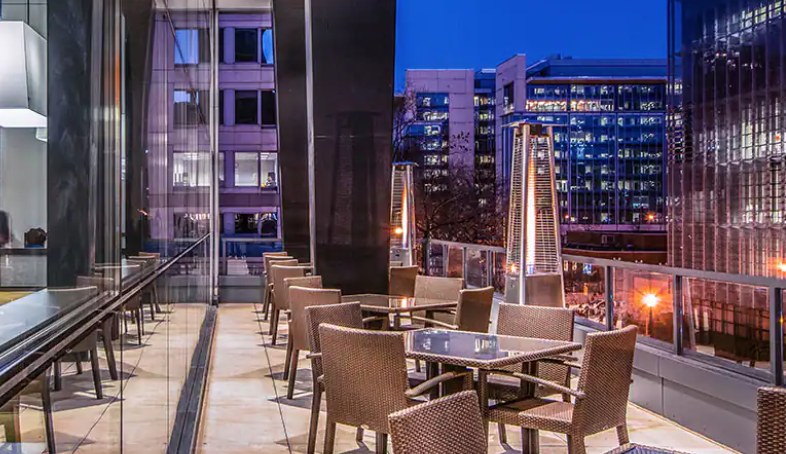
Hyatt Place Hotel Dining
Wake up to breakfast served daily at Hyatt Place Washington DC/ National Mall.Grab a snack from our 24/7 Gallery Market—and go!Enjoy the incredible Washington D.C. views with delicious cocktails at our rooftop bar.Breakfast Barcurrently featuring a selection of individually wrapped, pre-packaged breakfast items such as fresh fruit, yogurt, and more.The PlaceryWhen cravings strike, head to The Placery located at the lobby bar.Here, you’ll find a thoughtfully sourced, cleverly curated menu that has something for everyone. Try the popular burger, Chicken Caesar Salad, or Turkey Pesto Sandwich. And don’t forget to pair it with one of their premium alcoholic beverages.With comfortable spaces to lounge and seating at the bar, you’re welcome to post up for the afternoon or grab something to go if you’re just passing through.The MarketVisit The Market for a selection of perfectly packaged grab-and-go items.CityBar Rooftop BarEnjoy a cocktail and take in the stunning views of the Washington DC Skyline from our seasonal rooftop bar.
CityBar DC is expected to open for the 2021 season on September 1st.
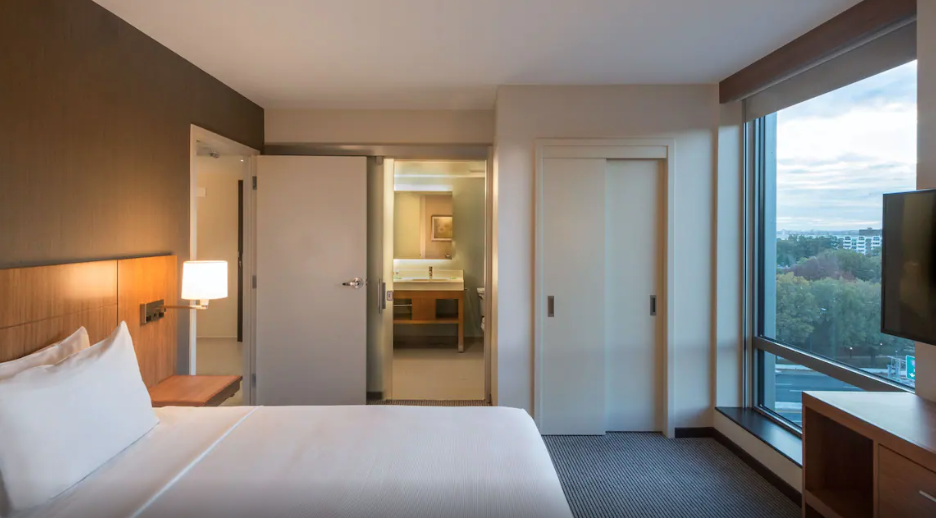
Your Spacious Hyatt Place Hotel Room
All of Hyatt’s spacious hotel rooms in Washington, D.C. feature Hyatt Luxury Pillowtop Mattress, modern media and work centers, 42″ TV, Cozy Corner with sofa or sofa-sleeper, and bathroom with granite countertops and free amenities. Forget something? Hyatt Necessities have you covered with must-have items you can buy, borrow, or enjoy for free while you stay in the Washington, D.C. accommodations.
Enjoy this 770 to 880-square-foot suite featuring a separate bedroom and living area with floor-to-ceiling windows, including one king bed with a Hyatt Luxury Pillowtop Mattress.Amenities
- Kitchenette with microwave
- Dining area with seating for 4
- Bathroom with dual vanity
- Swiveling 42″ flat-screen HDTV
- Oversized Cozy Corner with sofa sleeper
- Coffeemaker
- AM/FM alarm clock radio
- Separate workspace
- Cordless speakerphone with voicemail
- Minifridge with freezer
- Wet/dry bar
- Iron, ironing board, and hair dryer
Post Views: 247





